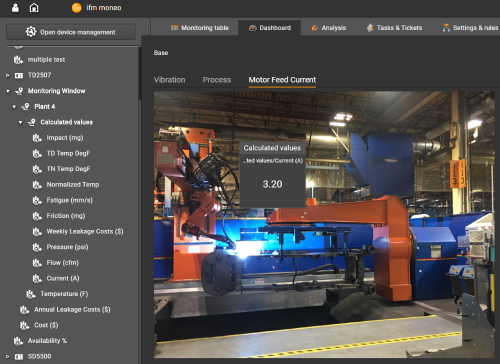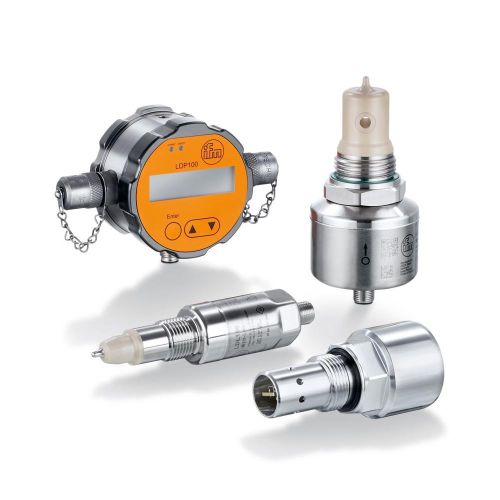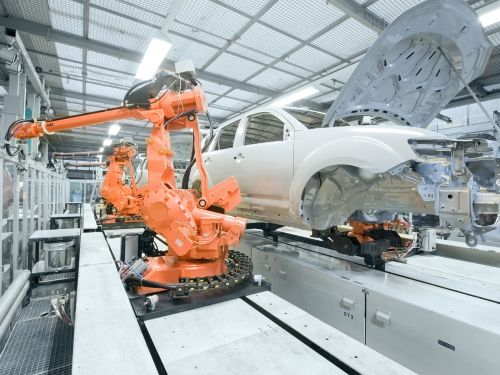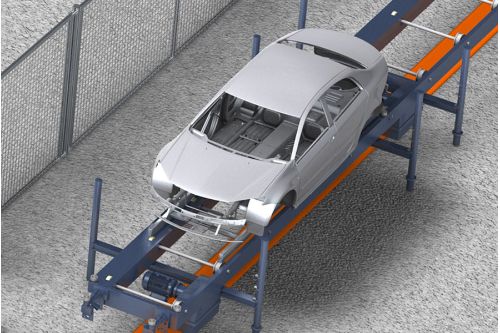- Automotive Industry
- Metal processing
Automated metal processing
Automotive manufacturing relies on significant amounts of metal components that are fabricated from molten metal into large sheet metal sections and down to smaller parts. Processing of these metal components relies on expensive machinery, and the ongoing maintenance of these machines requires significant capital investment.
Optimize your automated metal processing machinery
Automated metal processing is pivotal in meeting the high-volume, high-quality demands of the automotive industry. Metal fabrication has always been a foundational component to automotive manufacturing. But, new technologies can provide more insight into the health of these machines, providing data to help you confidently plan for maintenance. With increased understanding of machine health, you never have to worry about unexpected downtime due to maintenance that could have been scheduled.

Increased efficiency:
More reliable machine availability with monitoring and visibility of machine health for informed capital planning
Improved quality:
Access to real-time data provides insight into where to make process improvements
Reduced waste:
Real-time monitoring allows you to improve processes immediately instead of waiting to discover defective parts further down the line

CNC Machining: RFID solutions can help ensure the correct tools are selected. If the wrong tool is installed, it can cause a crash and damage to expensive equipment. If a tool bit breaks, a part can continue through the machining process, only to be inspected at the end of the process and scrapped. This results in expensive waste. With real-time sensor data, you can receive immediate alerts if a machine tool bit breaks during the first step of machining, allowing you to stop the process in real-time and make changes to reduce scrap.

Laser cutting: digital process sensors provide better insight into the precision cutting of various automotive components and materials. Gas flow sensors optimize the consumption of protective welding gas during operation, while other position and distance sensors ensure precision, safety, and efficiency.

Die casting: with real-time monitoring of coolant health, you can chart the gradual degradation of coolant. You no longer have to wait until scheduled service checks to know if your coolant was sufficiently lubricating during machining. This provides confidence in the quality of your products.

Stamping press: with real-time sensor data and intuitive moneo|software, you can immediately gain visibility into the health of your stamping press. Instead of relying on time-based maintenance schedules, machine data gives you greater flexibility in planning out capital investments for maintenance, without interfering with machine controls or involving IT. Integration time can be as little as 4 hours.
Impact of real-time monitoring during metal processing
Cost
The cost consideration includes the investment in hardware, software, and labor costs of integration into existing systems. When you invest in components and software that are easy to implement, you can significantly reduce the overhead associated with installation. It can also help reduce ongoing maintenance costs if the components do not require advanced training or programming skills to troubleshoot.
Results
The ROI is significant when ensuring the availability of your critical equipment. Having insight into machine health is imperative for secondary automotive suppliers to meet production goals and fulfill contracts on schedule. This strengthens customer relationships and protects your business. Unexpected downtime can threaten contracts with endusers and lead to significant fines. Having confidence that you can meet contract terms helps you gain a competitive edge. Better insight into machine performance leads to higher product quality, which ensures safety of consumers and builds brand reputation. The ROI is significant for all tiers of the automotive industry.


Temperature sensors: temperature sensors are a great way to measure surface temperature of metal processing equipment without risking damage to the sensor.

Analytical sensors: conductivity and oil particle sensors help you monitor coolant health in real-time. There are multiple ways to implement continuous monitoring of oil degradation that happens to over time, depending on the properties of your coolant.

Pressure sensors: continuous pressure monitoring delivers real-time insights into performance of equipment during metal forming processes. You can identify pressure peaks or valleys that could signal an impact to product quality. This alerts you to a problem immediately, instead of waiting for a failed inspection further down the line.

Flow sensors: continuous flow monitoring with IO-Link enabled sensors can provide multiple process values at once. Monitor media temperature, flow rate, and totalized volume. The SU and SM series from ifm are great options for many metal forming applications.
Software
moneo|software provides a simple way to gain insight into the health of your automated metal processing machinery. Once IO-Link enabled sensors are implemented on equipment or production lines, you can start sending that data to moneo through the IIoT port of the IO-Link master. The intuitive drag and drop functionality means you can start visualizing your data immediately with little programming knowledge. Since the software does not require integration with your machine controls, you often can start viewing your data without involving IT or PLC programming.

Gaining a competitive edge with automated metal processing
Integrating new hardware and software for increased monitoring of automated metal processing systems allows automotive manufacturers to stay competitive in a quality-driven market. These technologies provide real-time insight into machine health, so you can plan capital investments more effectively, produce higher quality metal products, and have confidence in your ability to fulfill contracts.


